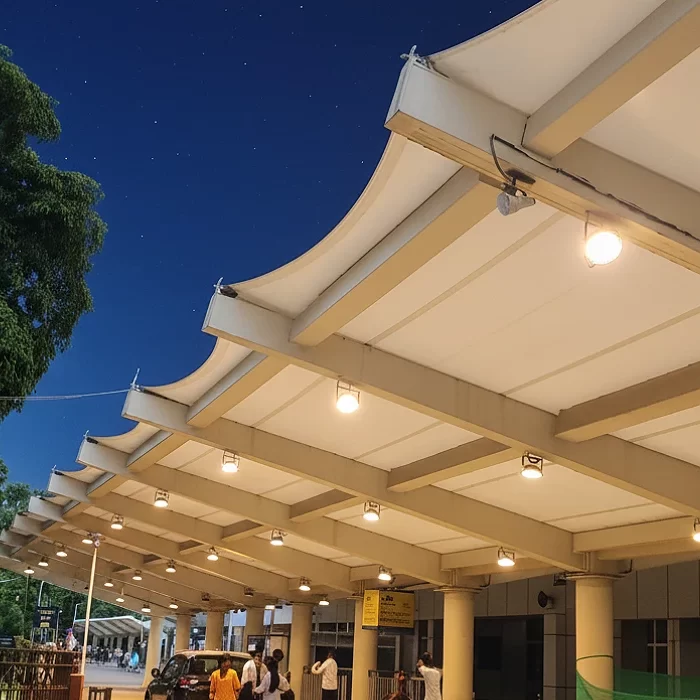
Common Mistakes to Avoid While Installing Tensile Structures
Common Mistakes to Avoid While Installing Tensile Structures 10 November 2025 Tensile fabric structures are admired for their strength, elegance, […]
12 August 2025
In the hospitality industry, first impressions matter. Resorts and hotels constantly strive to offer their guests unique experiences, comfortable stays, and visually appealing surroundings. One architectural solution that has gained immense popularity in recent years is tensile structures. Known for their durability, flexibility, and aesthetic appeal, tensile structures have become a preferred choice for resorts and hotels across the world.
Aesthetic Appeal That Attracts Guests
Guests today are not just looking for a place to stay they want an experience. Tensile structures are visually striking, with their flowing curves and modern designs that instantly capture attention. Whether used as a grand entrance canopy, a poolside shade, or an outdoor dining cover, these structures enhance the ambiance of any property. Their sleek designs often become a focal point, making the property stand out in a highly competitive hospitality market.
Versatility in Applications
One of the key reasons tensile structures are so popular in resorts and hotels is their versatility. They can be used in various areas, such as: Poolside and beachside shading solutions.Outdoor restaurants and bar areas.Walkway and pathway covers.Large event spaces for weddings or conferences
Parking shelters for guests
This flexibility makes tensile structures a perfect fit for resorts and hotels that want to offer multiple amenities while maintaining design consistency across their property.
Strength and Durability in All Climates
Hotels and resorts cater to guests year-round, so durability is crucial. Tensile structures are engineered using high-quality fabrics and steel frameworks that can withstand extreme weather conditions, including heavy rain, strong winds, and intense sun. They are also resistant to corrosion and UV rays, ensuring that the structures remain functional and attractive for years. This makes them a cost-effective investment for hospitality businesses that cannot afford frequent replacements or renovations.
Cost-Effective and Time-Efficient Construction
Unlike traditional concrete or wooden structures, tensile structures are lightweight and require less material. This results in lower construction costs. Moreover, the installation process is faster, allowing resorts and hotels to upgrade or expand facilities without long downtimes. This speed of execution ensures minimal disruption to daily operations, which is especially important for hotels that need to remain fully functional during renovations.
Promoting Eco-Friendly Hospitality
Sustainability has become a key focus in the hospitality sector, and tensile structures align perfectly with eco-friendly practices. Their design allows for natural light penetration, reducing the need for artificial lighting during the day. Additionally, the materials used are often recyclable and energy-efficient. Resorts and hotels that adopt tensile structures not only save on energy costs but also showcase their commitment to green initiatives something that today’s environmentally conscious travelers deeply value.
Customization for Brand Identity
Every hotel and resort wants to establish a unique identity. Tensile structures can be customized in terms of shape, size, and color to reflect the brand’s personality. From elegant white canopies that exude luxury to vibrant structures that create a lively atmosphere, tensile solutions can be tailored to match the theme and branding of the property. This customization helps hotels leave a lasting impression on their guests.
Common Mistakes to Avoid While Installing Tensile Structures 10 November 2025 Tensile fabric structures are admired for their strength, elegance, […]
How Tensile Structures Combine Aesthetics with Engineering Precision 1 November 2025 In the ever-evolving world of architecture, tensile fabric structures […]
The Science Behind Strength and Flexibility in Tensile Fabric Structures 16 October 2025 In the world of modern architecture, tensile […]
Why Tensile Structures are Ideal for Resorts and Hotels 12 August 2025 In the hospitality industry, first impressions matter. Resorts […]
What are the Future Trends in Tensile Structures 10 June 2025 In the ever-evolving world of modern architecture, tensile structures […]
Modern Tensile Solutions: Innovative by Arya Engineering 20 May 2025 In today’s world of architecture and civil engineering, modern tensile […]

